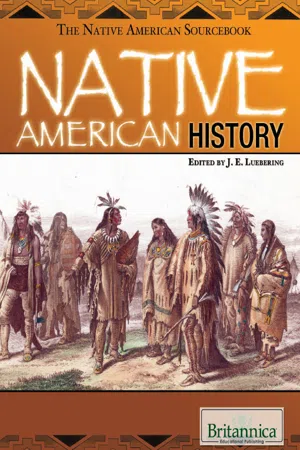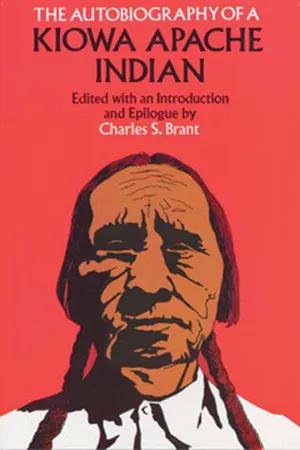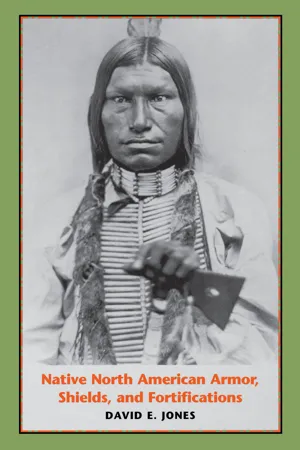Apache tribe
The Apache tribe is a Native American group known for their fierce resistance against European colonization in the southwestern United States. They were skilled warriors and hunters, and their nomadic lifestyle allowed them to adapt to various environments. The Apache people have a rich cultural heritage, with traditional practices and beliefs that continue to be celebrated today.
6 Key excerpts on "Apache tribe"
- eBook - ePub
- Britannica Educational Publishing, J.E. Luebering(Authors)
- 2010(Publication Date)
- Britannica Educational Publishing(Publisher)
...However, the ancestral Apache probably did not reach the Southwest until at least AD 1100. They apparently migrated to the area from the far north, for the Apachean languages are clearly a subgroup of the Athabaskan language family. With the exception of the Navajo, all other Athabaskan-speaking tribes were originally located in what is now western Canada. Although the Apache eventually chose to adopt a nomadic way of life that relied heavily on horse transport, semisedentary Plains Apache farmers were living along the Dismal River in what is now Kansas as recently as 1700. When the horse and gun trades converged in the central Plains about 1750, guerrilla-style raiding by previously nomadic groups such as the Comanche greatly increased. The remaining Plains Apache were severely pressured and retreated to the south and west. Culturally, the Apache are divided into Eastern Apache, which include the Mescalero, Jicarilla, Chiricahua, Lipan, and Kiowa Apache, and Western Apache, which include the Cibecue, Mimbreño, Coyotero, and Northern and Southern Tonto or Mogollon Apache. With the exception of the Kiowa Apache, who joined the Kiowa tribal circle (adopting Kiowa customs and allegiance), the Apache traditionally functioned without a centralized tribal organization. Instead, the band, an autonomous small group within a given locality, was the primary political unit as well as the primary raiding unit. The strongest headman of a band was recognized as an informal chief, and several bands might be united under one leader. Chieftainship was thus an earned privilege rather than a hereditary one. Once the Apache had moved to the Southwest, they developed a flexible subsistence economy that included hunting and gathering wild foods, farming, and obtaining food and other items from Pueblo villages via trade, livestock hunts, and raiding. The proportion of each activity varied greatly from tribe to tribe...
- eBook - ePub
- (Author)
- 2018(Publication Date)
- Lonely Planet(Publisher)
...Pueblo D2 20 Ute Mountain Reservation C1 21 Zia Pueblo D2 The People The cultural traditions and fundamental belief systems of the Southwest's tribes reflect their age-old relationship to the land, the water, the sky and the creatures that inhabit those elements. This relationship is reflected in their crafts, their dances and their architecture. Culturally, tribes grapple with dilemmas about how to prosper in contemporary America while protecting their traditions from erosion and their lands from further exploitation, and how to lift their people from poverty while maintaining their sense of identity and the sacred. The People by Stephen Trimble, published in 1993, is as comprehensive and intimate a portrait of Southwest native peoples as you'd hope to find, bursting with Native American voices and beautiful photos. Apache The Southwest has four major Apache reservations: New Mexico's Jicarilla Apache reservation and Mescalero Apache reservation, and Arizona's San Carlos Apache reservation and Fort Apache reservation, home to the White Mountain Apache tribe. Apache tribes descend from Athabascans who migrated from Canada around 1400. These nomadic hunter-gatherers became warlike raiders, particularly of Pueblo tribes and European settlements, and fiercely resisted their relocation to reservations. The most famous Apache is Geronimo, a Chiricahua Apache who resisted the American takeover of Indian lands until he was finally subdued by the US Army aided by White Mountain Apache scouts. Havasupai The Havasupai reservation abuts Arizona's Grand Canyon National Park beneath the Canyon's south rim. The tribe's one village, Supai, is reached by an 8-mile hike or a mule or helicopter ride from road's end at Hualapai Hilltop. Havasupai (hah-vah- soo -pie) means 'people of the blue-green water,' and tribal life has always been dominated by the Havasu Creek tributary of the Colorado River...
- eBook - ePub
- (Author)
- 2018(Publication Date)
- Lonely Planet(Publisher)
...Native Americans According to the 2010 census California has the largest Native American population in the country, with Arizona and New Mexico ranking in the top 10. The Navajo tribe is the largest western tribe, second only to the Cherokee nationwide. Culturally, tribes today grapple with questions about how to prosper in contemporary America while protecting their traditions from erosion and their lands from further exploitation, and how to lift their people from poverty while maintaining their sense of identity and the sacred. Big Mountain For decades, traditional Navajo and Hopi have thwarted US industry efforts to strip mine sacred Big Mountain. Black Mesa Indigenous Support (www.supportblackmesa.org) tells their story. The Tribes Most of the major Western tribes are located in the Southwest. Well-known tribes with large reservations in Arizona include the Navajo, the Hopi and the Apache. Two smaller Arizona tribes, the Hualapai and the Havasupai, live on reservations beside the Grand Canyon. New Mexico's tribes are clustered in 19 pueblos located in the north-central region of the state. One of the best museums devoted to Southwest Native American life and culture is Phoenix's Heard Museum. Apache The Southwest has three major Apache reservations: New Mexico's Jicarilla Apache Reservation and Arizona's San Carlos Apache Reservation and Fort Apache Reservation, home to the White Mountain Apache tribe. All the Apache tribes descend from Athabascans who migrated from Canada around 1400. They were nomadic hunter-gatherers who became warlike raiders, particularly of Pueblo tribes and European settlements, and they fiercely resisted relocation to reservations. The most famous Apache is Geronimo, a Chiricahua Apache who resisted the American takeover of native lands until he was finally subdued by the US Army with the help of White Mountain Apache scouts. ETIQUETTE When visiting a reservation, ask about and follow any specific rules...
- eBook - ePub
- Mark Q. Sutton(Author)
- 2021(Publication Date)
- Routledge(Publisher)
...When U.S. troops left the Southwest in 1861 to fight the Civil War, the Navajo thought they had been victorious and so intensified their raiding against the Pueblos and Euroamerican settlers. The United States responded by waging total war against the Navajo, defeating them in 1864. Most Navajo were imprisoned until 1868, after which they settled on the newly created Navajo Reservation (see the case study on the Navajo later in this chapter). The Apache resisted American colonization, but the United States had defeated the last of their groups by 1886. The government established reservations for various Apache groups in or near their lands in the Southwest. The one exception was the Chiricahua Apache from New Mexico, who had given the government the most trouble and who were all imprisoned in Florida in 1886. They were moved to Alabama in 1887 and, in 1894, they were moved to a reservation near Fort Sill, Oklahoma. In 1913, the Chiricahua were given the option to move to the Mescalero Reservation in Arizona or to stay at Fort Sill. Most returned to Arizona, but some stayed in Oklahoma (see Lieder and Page 1997). In 2011, the government allowed the Fort Sill Apache to move back to New Mexico and establish a reservation, the culmination of a 125-year effort, though some remained at Fort Sill. As of 2010, there were some 112,000 Apache (2010 census data, www.census.gov/population/www/cen2010/cph-t/t-6tables/TABLE%20(1).pdf). The Impact of European Contact Europeans impacted Southwestern societies both culturally and biologically. The colonial administrations of Spain, Mexico, and the United States all left their mark on the region (see Spicer 1962). In spite of these influences, many Southwestern groups managed to retain much of their traditional culture. It has been estimated (Upham 1992:230–233; also see Stodder and Martin 1992) that some 90 pueblos with approximately 200,000 people existed in A.D...
- eBook - ePub
- Charles S. Brant(Author)
- 2013(Publication Date)
- Dover Publications(Publisher)
...Sections of nine counties of southwestern Oklahoma. The Kiowa Apache live near the towns of Fort Cobb and Apache. Introduction The Cultural and Historical Background THE KIOWA APACHE, presently living on government allotments of land near the towns of Fort Cobb and Apache in southwestern Oklahoma, are an Apachean-speaking people who, in pre-contact times, ranged both further north and south, at times reaching Mexico on raids for horses and captives. Never numbering more than about three hundred fifty, they have been traditionally associated with the much larger Kiowa tribe, a people speaking an entirely unrelated language and following a mode of life typical of Indians of the Great Plains area. So far as Kiowa Apache tradition goes, they have never known a time when they were not associated with the Kiowa. This, however, does not mean that the Kiowa Apache were in any sense merely a segment of the Kiowa; they were a distinct cultural entity, but roved the Plains region in close proximity to the Kiowa, probably for reasons of security from dangers posed by much larger, warlike peoples. On such major ceremonial occasions as the Sun Dance, they camped with the Kiowa and functioned as a band in the camp circle. They had their own leaders in the hunt and in warfare and their own distinctive body of custom and traditions. Contrary to the premature conclusion voiced by certain writers that the Kiowa Apache were very similar culturally to the Kiowa, closer investigation reveals important differences in social organization, folklore and beliefs. A large number of these features, when cast in comparative ethnological perspective, show unmistakably that the nearest cultural relatives of the Kiowa Apache are the eastern groups of Apache of New Mexico, especially the Jicarilla and Lipan Apache...
- David E. Jones(Author)
- 2010(Publication Date)
- University of Texas Press(Publisher)
...The Pueblo peoples were the most committed horticulturalists of the Southwest, while the Apache were probably the least. The Navaho combined the hunting and gathering of the Apache with the horticulture of the Pueblo and later the animal husbandry introduced by the Spanish. Groups like the Pima and Mohave practiced horticulture but were more dependent on hunting and gathering than the Pueblo peoples. While the Navaho and Apache are comparatively modern citizens of the Southwest, evidence of the earliest inhabitants dates to over 20,000 years ago. Because the ancestral Pueblo and later prehistoric Pueblo populations built impressive structures and left millions of ceramic artifacts, their history is better known than, for example, that of the Yuman farmers of the lower Colorado River. Archaeological evidence indicates that up to about 900 A.D. the Southwestern Indians were basically hunters and gatherers with some small reliance on cultigens. During the first few centuries A.D., corn horticulture became increasingly important. People gathered in larger living groups and built pit houses with sizable storage caches for corn. Around 800–900 A.D. pit houses gave way to larger above-ground habitations. After 900 A.D. big masonry, multistoried pueblos with kivas (ritual chambers) and blocks of rooms appeared. These structures were first described by the Spanish explorers and today can be seen in the Southwest, still housing viable Indian populations. Evidence of warfare appears in the archaeological record from 1 A.D. to 900 A.D., during which time hunting and gathering shifted toward horticulture and small nomadic groups grew to larger sedentary groups. Some fortification building occurred, but it was relatively minor. From 900 to 1200, warfare declined but picked up again about 1250...





